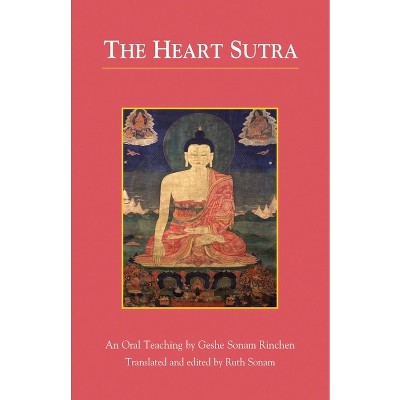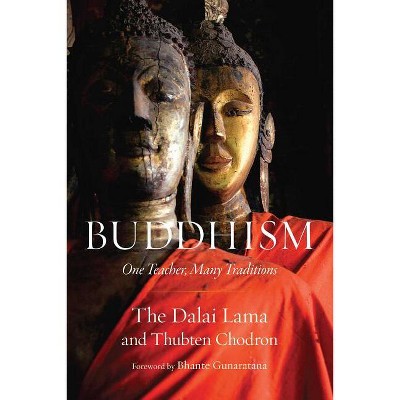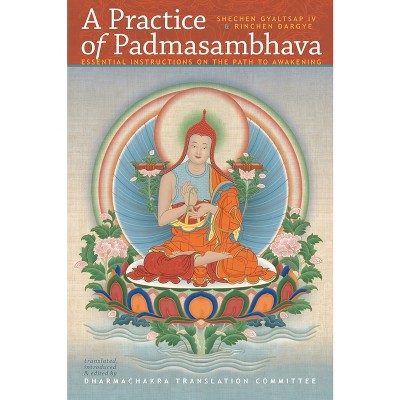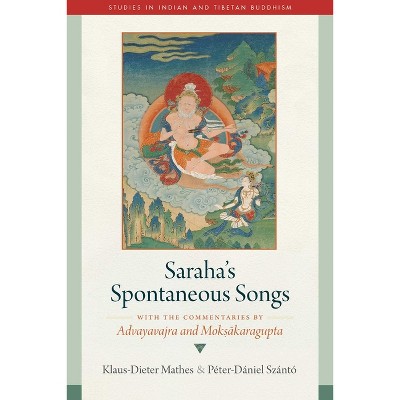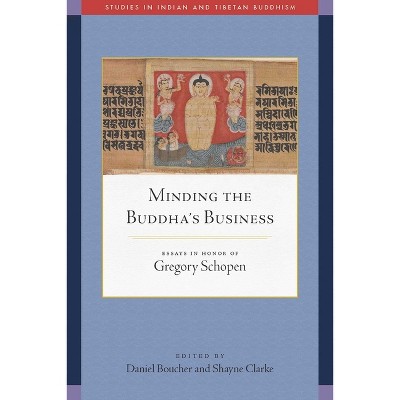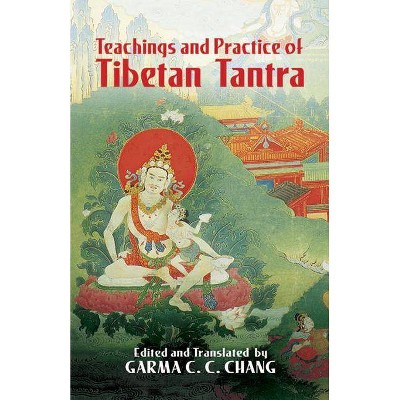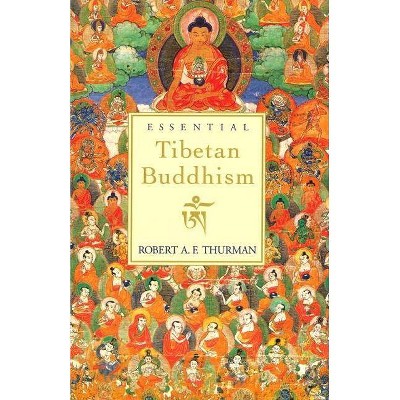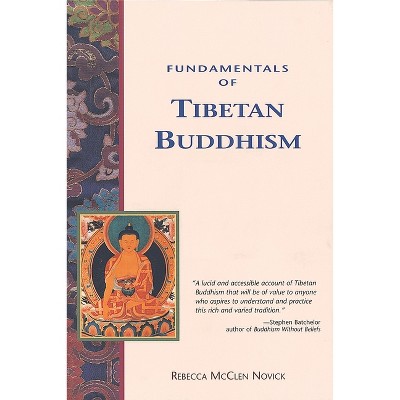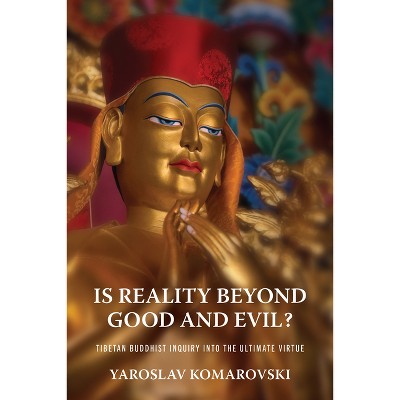Sponsored

The Vajrabhairava Tantra - (Studies in Indian and Tibetan Buddhism) by Aleksandra Wenta (Hardcover)
$79.95
In Stock
Eligible for registries and wish lists
Sponsored
About this item
Highlights
- A groundbreaking work on the little-studied Indian origins of an influential tantric Buddhist practice along with a fresh English translation.
- About the Author: Aleksandra Wenta is an associate professor in Indology and Tibetology at the University of Florence, Italy.
- 376 Pages
- Religion + Beliefs, Buddhism
- Series Name: Studies in Indian and Tibetan Buddhism
Description
About the Book
"This book is a study and translation of the Vajrabhairava Tantra (henceforth, VBhT), a Buddhist tantric text in seven chapters that focuses on the means of attainment (såadhana) centered upon the wrathful tantric deity Vajrabhairava. The VBhT, composed in India in the eighth century and written in Sanskrit, is attributed to Lalitavajra (a.k.a. Låilåavajra), a Buddhist master (åacåarya) at Nåalandåa Monastery, who is said to have retrieved it from the land of Oòdòdiyåana. It is a work of great importance to the development of tantric Buddhism in India as well as to the understanding of Tibetan Buddhist history more generally. Like most tantras, it is a ritual text, dedicated in all of its seven chapters to the description of rites, such as the drawing of the sacred diagram (maònòdala), the ceremonies performed within it, as well as the performance of various rituals, such as magical rituals (karmas), fire offerings (homa), recitation of sacred spells (mantras), and so on. The VBhT deals with what might have been the earliest form of Vajrabhairava, the Solitary Hero (ekavåira), in the charnel ground surrounded by various mortuary objects, weapons, and eight zombies. All of these gruesome symbols clearly reflect the transgressive character of the tantra, associated with the tantric cult of the cremation ground and antinomian practices involving contact with impure places and substances as a means of attaining power. In the subsequent centuries, the pantheon of the Vajrabhairava maònòdala grew, giving rise to the Seventeen-and the Thirteen-Deity maònòdalas. The latter was directly influenced by the pantheon of the Guhyasamåaja Tantra, and could be seen as its direct evolution (Tanaka 2018, 323). Indeed, Thirteen-Deity Vajrabhairava gained widespread popularity also outside India-in Tibet, Mongolia, and China"--Book Synopsis
A groundbreaking work on the little-studied Indian origins of an influential tantric Buddhist practice along with a fresh English translation. The deity Vajrabhairava, or Yamantaka, is well known as the central figure of tantric practice in multiple lineages of Tibetan Buddhism and is also found in Chinese and Japanese Buddhism. Less is known about its foundational Indian context. The Vajrabhairava Tantra, dedicated to the Buffalo-headed deity Vajrabhairava, arose around the eighth century and had a considerable impact on the formation of religious praxis in the medieval Indian Buddhist world. This book contains a translation of the Vajrabhairava Tantra from the recently discovered Sanskrit text and a comprehensive study of its elements, of its origins and Indian commentators, and of the history of its transmission to Tibet. The annotation to the translation excerpts all six Indian commentaries on the tantra found in the Tibetan canon. One highly innovative contribution this work makes to the fields of tantric Buddhist studies and, more generally, to South Asian religions is the way it breaks down traditional disciplinary boundaries between tantra and magic. It shows that the genesis of tantric traditions cannot be reduced to a one-way influence of Hindu Shaivism on Buddhism or vice versa, but indicates a widespread "culture of magic," a common "ritual syntax," that crossed sectarian, linguistic, and socio-cultural boundaries, one that came to be significantly diminished in later Shaiva and Buddhist tantras. The study comprises the first half of the book, and the second half is the translation, which explains the construction of the mandala, the magical applications of the practice, the extraction of the mantra, the visualization, and the preparation of the pata painting and the homa fire ritual. A dozen color plates illustrate Vajrabhairava in his Solitary Hero and other forms along with mandalas of five different lineages, keys for which are provided in the appendix. Not only is the English translation of the Vajrabhairava Tantra the first to be based on a Sanskrit manuscript, but also the comprehensive study of all six canonical commentaries is the first to investigate the key commentaries by Akshobhya and Krishnacharya.Review Quotes
"Aleksandra Wenta's The Vajrabhairava Tantra: A Study and Annotated Translation is an important new work in the field of Buddhist Studies. It focuses on The Vajrabhairava Tantra, an important Indian tantric Buddhist work with strong connections with Saiva and Sakta Hindu traditions, and which became very influential in Tibet. Its solid English translation makes this text available to a much wider audience. It also features a detailed introduction that sheds light on the text's history, and discusses the ritual and contemplative practices described by the text. This text is a must-read for anyone interested in the history and development of tantric traditions in India and Tibet. It should also be of interest to tantric practitioners seeking to learn more about the scriptural foundations of contemporary practice traditions. Art historians should also take note of the text's fifth chapter, which details the procedure for painting sacred images of the deity in this tradition.--David B. Gray, Bernard J. Hanley Professor of Religious Studies, Santa Clara University
"Aleksandra Wenta's masterful translation of the Vajrabhairava Tantra sets a new gold standard in Buddhist tantric studies. Her rigorous intertextual analysis demonstrates how tantric practices transcended sectarian boundaries, illuminating the complex interplay between Buddhist and Saiva textual traditions, iconography, and ritual systems in medieval India. This definitive work corrects previous translations and transforms our understanding of a spellbinding tantric text that has shaped religious traditions across Asia for centuries."--Bryan J. Cuevas, translator of The All-Pervading Melodious Drumbeat: The Life of Ra Lotsawa
"An important contribution to our knowledge of Vajrayana Buddhism, this clear and insightful book sheds light on topics including the influence of Saivism on Buddhist tantric practice, and the role of violent and 'love' magic in the tantras. Wenta follows the traces of Vajrabhairava in India through to the deity's transmission to Tibet, and its central role in the practices of the Sakya and Geluk schools. Essential reading."--Sam van Schaik, head of the Endangered Archives Programme at the British Library and author of Tibet: A History
"Wenta's study and translation, based on the Sanskrit and Tibetan texts and commentaries, presents an important eighth-century tantric Buddhist text that has received surprisingly little previous attention from scholars. Features include its substantial use of Saiva elements and the many insights it offers into later stages of Buddhist tantra. Wenta's introduction lucidly discusses the various issues associated with the text and its history, while her translation gives a clear English version with detailed notes. Scholars of tantra and related areas will find much of value."--Geoffrey Samuel, professor, School of Religious and Theological Studies at Cardiff University and author of Tantric Revisionings
About the Author
Aleksandra Wenta is an associate professor in Indology and Tibetology at the University of Florence, Italy. She holds an MPhil and a PhD from the University of Oxford and a Vidyavaridhi (PhD) degree from Banaras Hindu University. She was an assistant professor and a member of the founding faculty of Buddhist studies at Nalanda University (2016-20) and a fellow-in-residence at the Indian Institute of Advanced Study, Shimla (2012-14). Her research focuses on the history, ritual, and literature of tantric Buddhism and Saivism and Indo-Tibetan Buddhism, and she recently coedited the volume Tibetan Magic: Past and Present (Bloomsbury, 2024).Dimensions (Overall): 9.07 Inches (H) x 6.43 Inches (W) x 1.22 Inches (D)
Weight: 1.65 Pounds
Suggested Age: 22 Years and Up
Number of Pages: 376
Genre: Religion + Beliefs
Sub-Genre: Buddhism
Series Title: Studies in Indian and Tibetan Buddhism
Publisher: Wisdom Publications
Theme: Sacred Writings
Format: Hardcover
Author: Aleksandra Wenta
Language: English
Street Date: September 2, 2025
TCIN: 1001852520
UPC: 9781614298472
Item Number (DPCI): 247-14-6157
Origin: Made in the USA or Imported
If the item details aren’t accurate or complete, we want to know about it.
Shipping details
Estimated ship dimensions: 1.22 inches length x 6.43 inches width x 9.07 inches height
Estimated ship weight: 1.65 pounds
We regret that this item cannot be shipped to PO Boxes.
This item cannot be shipped to the following locations: American Samoa (see also separate entry under AS), Guam (see also separate entry under GU), Northern Mariana Islands, Puerto Rico (see also separate entry under PR), United States Minor Outlying Islands, Virgin Islands, U.S., APO/FPO
Return details
This item can be returned to any Target store or Target.com.
This item must be returned within 90 days of the date it was purchased in store, shipped, delivered by a Shipt shopper, or made ready for pickup.
See the return policy for complete information.









